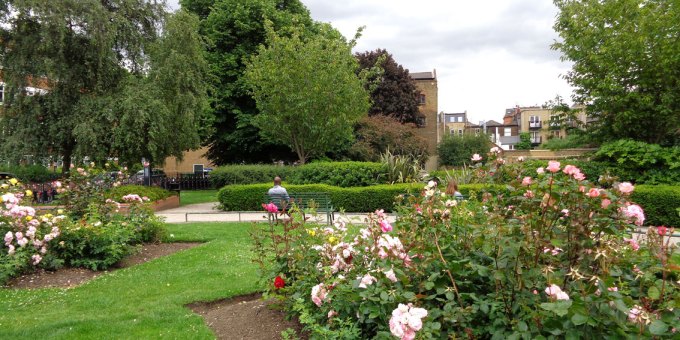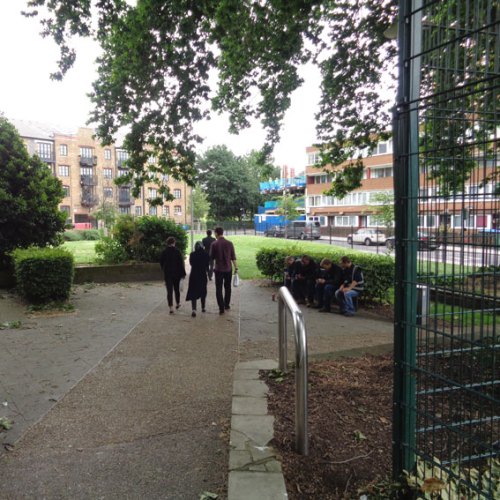
Skins and bounces (Monday 12 June 2017)
Leathermarket gardens
From the end of the 17th century, after the Great Fire of London, noxious and unpleasant activities such as tanning and leather working were banned from the tightly populated streets of the City of London. These industries found their way over the river to Bermondsey where they thrived with less regulation, a plentiful supply of fresh water from tidal streams and the River Neckinger (today flowing entirely through underground culverts and sewers) and close to the oak wooded slopes just to the south: sources of the tannin- rich oak bark used in the tanning process. By the 19th century, every possible aspect of the leather process happened in this square mile, from skinning to saddle making. It’s estimated that a third of the country’s leather came from here.
I walk towards the gardens, through streets where old brown bricked warehouses stand tall and narrow, many still adorned with winches and chains. Now mostly loft apartments, studios and offices. One bears the painted trace of ‘LEATHER FACTORS’ on its brickwork. I try to imagine passing through here a century and a half ago: laden carts clattering on filthy cobbles. Sweaty aproned workers, shouldering piles of hides. Shouting, whistling, hammering from all sides. Steam and coal smoke. Dust and detritus. But above all, the powerful stench, a foul mix of the smell of putrefication and the ingredients used in the tanning process, which included lime and urine to remove hairs and dog faeces to soften the leather. Dark and dismal alleys wound between miserable housing and rat infested storehouses.

Thankfully that squalid vision ruptures and dissipates as I turn in at the garden’s gate. Although pretty cloudy today, there’s still a vibrant punch of colour from the rose beds which fill this eastern segment of the park. Overlooked by the redeveloped warehouses of the Morocco Store (named after Morocco leather made from goat skin, which was soft and used to make gloves, uppers of shoes and for bookbinding). I’m led along brick edged paths, one or two sunshine glances to dapple the tarmac, between hedges and around the more intimate central circular garden. A woman sits on the lawn, on an African rug, surrounded with bags and suitcases. Looking lost. Rose bushes bursting behind her like fireworks. I meander towards the western hummocky lawns, past stands of trees, cherry, laburnum, maple. From various angles the Shard (only 350 metres northwest of here), glints like a sharpened blade between bright white birches, thrusts out of the roofs of the neighbouring Guinness Trust buildings, or rises into the clouds like a blue ladder above the Bermondsey Village Hall.

The gardens are named after the Leather and Skin Market, which was opened in the 1830s, on Weston Street, a short dash to the south (now home to Workspace which offers studio and office space for start up businesses). Up to 50 salesmen would trade their hides and raw animal skins here in noisy and hectic surroundings. Later, in the 1870s, The more elegant London Leather, Hide and Wool Exchange was opened next door, where business could be conducted in more affable surroundings. The building’s frontage displays five stone reliefs (see below) that depict stages in the leather making process. There was even a pub, which still stands here (now called The Leather Exchange) looking across to the park’s southern gate.

The turn of the century saw a decline in Bermondsey’s dominance of the leather industry. Changes in the process, cheaper rents and labour costs away from London saw other centres, such as Liverpool and Leeds taking over. And, after the First World War, the rise in motor transport over the use of horses led to a drop in the demand for saddles and harnesses. Heavy bombing of this industrial district during the Second World War brought many tanneries to ruin and the postwar rise in synthetic plastics reduced leather making to a specialist industry. The last working tannery, S.O.Rowe & Son moved out of London in 1997.

I return to the eastern garden segment, to draw the view across the rose beds (see drawing at top). This was the first part of these gardens to be opened, in the 1930s, as a garden square to serve the neighbourhood. The rest of the gardens were recovered in the 50s from postwar bomb sites, where once were warehouses and sheds, and laid out to lawns and shrubberies.
The garden is busy, with many people strolling through. Some walking dogs. Others eating lunch on green park benches or under a shaded pergola. A terrier runs up and down the grass paths between the beds. It’s owner calls “Datsun!” I think I’ve misheard until I hear again- “c’mon DATSUN!” Hmm, maybe a Japanese Terrier?
Gusts of breeze set rose heads nodding. Alive like a bright hatted audience, swaying to a beat. Their heady perfume wafts in aerosol bursts.

Guy Street Park
Drawing finished, I walk back through and cross over to Guy Street Park. These two green spaces almost connect, point to point, across Weston Street. In spring, a trail of crocuses decorate a colourful winding trail from Leathermarket Garden over to this open, diamond shaped flatness of lawns. A path, straight as a stripe, cuts across. Other, curving paths lead past beds and around a small pergola, heavy with clematis and honeysuckle. A shrubbed squeeze up some shaded steps into an upper level, with playground and basketball court. Closely overlooked by a multi storey car park and the scaffolded shell of an apartment block under construction. A glimpse from the northwest corner, up Kipling Street to the primary colours of the newly opened, state of the art Cancer Centre at Guys Hospital.

Guy’s Hospital was founded in the 1720s by entrepreneur and benefactor, Thomas Guy. Until the mid nineteenth century this piece of former grazing land was used as the hospital’s burial ground for deceased patients. In the 1890s it was bought by London County Council, refurbished and laid out as Nelson Recreation Ground (with tennis courts, lawns and swings). Much needed in this heavily populated and, at the time, industrialised district.
I struggle for a suitable drawing location so decide to go up to 6th floor of the multi storey NCP car park. From here I have a birds eye view of the park (see drawing at bottom). I’m up amongst the shivering plane tree tops. Looking down, a group of basketball players are clustered around one end of the court, practising shots at the net. Shouts and laughs. A satisfying metallic clang when the ball goes through the hoop. One player is kicking another ball through the opposite posts, clashing it against the chain fence behind. Hammering from building works to my left adds to the percussion.

The recreation ground suffered bomb damage during the 2nd World War. It was restored but deteriorated through the latter half of the 20th century through neglect and vandalism. Its unlit corners perfect for dealing and using drugs. In 2000, tenants groups campaigned as the Friends of Guy Street Park. They succeeded in getting funding to redevelop the park to its current plan, with support from Southwark Council and the Pool of London Partnership. As a way to improve lighting, artist Mark Haywood was commissioned to produce a series of large lightboxes which were hung on the side of the car park to display artwork from artists, schools and community groups.
Squeals of tyres and engines revving echo around the concrete cavern behind me. A pigeon struts along the wall close to where I’m drawing. He cocks his head and blinks at me. Then flaps noisily away into the tree when I move to rinse my brush.
A yell from below! A basketball escapes the court and bounces once into Kipling Street, once on the wing of a parked car and rolls in front of a woman pushing a buggy on the opposite pavement. She retrieves then expertly lobs it in an arc to the approaching player.

(In his ‘Sticks in the Smoke’ project, Nick Andrew has been visiting, researching and drawing a different public park or garden in London since January 2016. This is leading to a collection of paintings exploring the theme of city green spaces from the perspective of a rural landscape painter. These will be shown in a London exhibition in 2018. www.nickandrew.co.uk
Leathermarket Gardens, Weston Street, Bermondsey, London. SE1 3RG
Guy Street Park, Weston Street, Bermondsey, London. SE1 3SH
Unrestricted opening.
Google earth view here
Fascinating. Wonderful sketches and interesting histories.
LikeLike
Thankyou Sonia!
LikeLike
Your piece on the Leather Market Gardens struck a real chord with me, Nick. My grandfather and his father were both leather workers in the second half of the 19thC and though their business was carried out in Hoxton, north of the River, other leather-working members of the family carried on their business in Bermondsey and helped boost the trade there. Thank you for that and the lovely sketch of the rose beds. And a great view from the carpark; just like the Impressionists used to do, from Paris balconies! x
LikeLike
Thankyou for your kind comments Sally. I’m glad it evoked family connections with the leather industry. X
LikeLike